Manchukuo
| Puppet state of the Empire of Japan | ||||||||||
| ||||||||||
| ||||||||||
| Anthem National Anthem of Manchukuo | ||||||||||
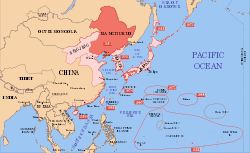 Location of Manchukuo (red) within Imperial Japan's sphere of influence. | ||||||||||
| Capital | Hsinking (Changchun) (until August 9, 1945) Tonghua (Linjiang) (until August 18, 1945) | |||||||||
| Languages | Japanese Mandarin Mongolian Manchu (unofficial)[1] | |||||||||
| Government | One-party state under constitutional monarchy | |||||||||
| Chief Executive | ||||||||||
| • | 1932–1934 | Aisin-Gioro Puyi | ||||||||
| Emperor | ||||||||||
| • | 1934–1945 | Kangde (Aisin-Gioro Puyi) | ||||||||
| Prime Minister | ||||||||||
| • | 1932–1935 | Zheng Xiaoxu | ||||||||
| • | 1935–1945 | Zhang Jinghui | ||||||||
| Legislature | Legislative Council | |||||||||
| Historical era | Interbellum · World War II | |||||||||
| • | Proclaimed | 18 February 1932 | ||||||||
| • | Disestablished | August 1945 | ||||||||
| Currency | Manchukuo yuan | |||||||||
| ||||||||||
| Today part of | | |||||||||
| Manchukuo | |||||||||||||||||||||
| Chinese name | |||||||||||||||||||||
|---|---|---|---|---|---|---|---|---|---|---|---|---|---|---|---|---|---|---|---|---|---|
| Traditional Chinese | 滿洲國 | ||||||||||||||||||||
| Simplified Chinese | 满洲国 | ||||||||||||||||||||
| Literal meaning | Manchu State | ||||||||||||||||||||
| |||||||||||||||||||||
| Japanese name | |||||||||||||||||||||
| Kanji | 満州国 | ||||||||||||||||||||
| Kana | まんしゅうこく | ||||||||||||||||||||
| |||||||||||||||||||||
| Great Empire of Manchukuo | |||||||||||||||||
| Chinese name | |||||||||||||||||
|---|---|---|---|---|---|---|---|---|---|---|---|---|---|---|---|---|---|
| Traditional Chinese | (大)滿洲帝國 | ||||||||||||||||
| Simplified Chinese | (大)满洲帝国 | ||||||||||||||||
| Literal meaning | (Great) Manchu Empire | ||||||||||||||||
| |||||||||||||||||
| Japanese name | |||||||||||||||||
| Kanji | (大)満州帝国 | ||||||||||||||||
| Kana | (だい)まんしゅうていこく | ||||||||||||||||
| |||||||||||||||||
Manchukuo (traditional Chinese: 滿洲國; pinyin: Mǎnzhōuguó; Japanese: 満州国; literally: "State of Manchuria") was a puppet state in Northeast China and Inner Mongolia, which was governed under a form of constitutional monarchy. The area, collectively known as Manchuria by westerners and Japanese, was designated by China's erstwhile Qing Dynasty as the "homeland" of the ruling family's ethnic group, the Manchus, but the Manchus themselves never used "Manchuria" (滿洲) as a place name to refer to the area. In 1931, the region was seized by Japan following the Mukden Incident and a pro-Japanese government was installed one year later with Puyi, the last Qing emperor, as the nominal regent and emperor.[2] Manchukuo's government was abolished in 1945 after the defeat of Imperial Japan at the end of World War II. The territories formally claimed by the puppet state were first seized in the Soviet invasion of Manchuria in August 1945,[3] and then formally transferred to Chinese administration in the following year.[lower-alpha 1]
Manchus formed a minority in Manchukuo, whose largest ethnic group were Han Chinese. The population of Koreans increased during the Manchukuo period, and there were also Japanese, Mongols, White Russians and other minorities. The Mongol regions of western Manchukuo were ruled under a slightly different system in acknowledgement of the Mongolian traditions there. The southern part of the Liaodong Peninsula was ruled by Japan as the Kwantung Leased Territory.
History
Terminology
"Manchuria" is a transcription of the Japanese reading of the Chinese word "滿洲" which means Manchuria, which in Japanese is Manshū, which in turn dates from the 19th century. The name Manzhou was invented and given to the Jurchen people by Hong Taiji in 1635 as a new name for their ethnic group. However, the name "Manchuria" was never used by the Manchus or the Qing dynasty itself to refer to their homeland.
According to the Japanese scholar Junko Miyawaki-Okada, the Japanese geographer Takahashi Kageyasu (高橋景保) was the first to use the term 满洲 (Manshū) as a place name in 1809 in the Nippon Henkai Ryakuzu (日本辺海略図), and it was from that work where Westerners adopted the name.[4][5] According to Mark C. Elliott, Katsuragawa Hoshū's 1794 work, the Hokusa bunryaku (北槎聞略), was where 满洲 (Manshū) first appeared as a place name, in two maps included in the work: "Ashia zenzu" and "Chikyū hankyū sōzu" which were also created by Katsuragawa.[6] 满洲 (Manshū) then began to appear as a place names in more maps created by Japanese like Kondi Jūzō, Takahashi Kageyasu, Baba Sadayoshi and Yamada Ren. These maps were brought to Europe by the Dutch Philipp von Siebold.[7]
According to Nakami Tatsuo, Philip Franz von Siebold was the one who brought the usage of the term Manchuria to Europeans, after borrowing it from the Japanese, who were the first to use it in a geographic manner in the eighteenth century, while neither the Manchu nor Chinese languages had a term in their own language equivalent to "Manchuria" as a geographic place name.[8] According to Bill Sewell, it was Europeans who first started using Manchuria as a name to refer to the location and it is "not a genuine geographic term."[9] The historian Gavan McCormack agreed with Robert H. G. Lee's statement that "The term Manchuria or Man-chou is a modern creation used mainly by westerners and Japanese", with McCormack writing that the term Manchuria is imperialistic in nature and has no "precise meaning", since the Japanese deliberately promoted the use of "Manchuria" as a geographic name to promote its separation from China while they were setting up their puppet state of Manchukuo.[10]
Background
The Japanese had their own motive for deliberately spreading the usage of the term Manchuria.[11] The historian Norman Smith wrote that "The term "Manchuria" is controversial".[12] Professor Mariko Asano Tamanoi said that she "should use the term in quotation marks", when referring to Manchuria.[13] Herbert Giles wrote that "Manchuria" was unknown to the Manchus themselves as a geographical expression.[14] Professor Chad D. Garcia noted that usage of the term "Manchuria" is out of favor in "currently scholarly practice" and he did away with using the term, using instead "the northeast" or referring to specific geographical features.[15]
The Qing Dynasty, which replaced the Shun and Ming dynasties in China, was founded by Manchus from Manchuria (modern Northeastern China). The Manchu emperors separated their homeland in Jilin and Heilongjiang from the Han Liaoning province with the Willow Palisade. This ethnic division continued until the Qing dynasty encouraged massive immigration of Han in the 19th century during Chuang Guandong to prevent the Russians from seizing the area from the Qing. After conquering the Ming, the Qing identified their state as "China" (中國, Zhongguo; "Central Realm") and referred to it as "Dulimbai Gurun" in Manchu.[16][17][18] The Qing equated the lands of the Qing state (including present day Manchuria, Xinjiang, Mongolia, Tibet and other areas) as "China" in both the Chinese and Manchu languages, defining China as a multi-ethnic state, rejecting the idea that China only meant Han areas, proclaiming that both Han and non-Han peoples were part of "China", using "China" to refer to the Qing in official documents, international treaties, and foreign affairs, and the "Chinese language" (Dulimbai gurun i bithe) referred to Chinese, Manchu, and Mongol languages, and the term "Chinese people" (中國人 Zhongguo ren; Manchu: Dulimbai gurun i niyalma) referred to all Han, Manchus, and Mongol subjects of the Qing. The lands in Manchuria were explicitly stated by the Qing to belong to "China" (Zhongguo, Dulimbai gurun) in Qing edicts and in the Treaty of Nerchinsk.[19]
During the Qing dynasty, the area of Manchuria was known as the "three eastern provinces" (三東省; Sān dōng shěng) since 1683 when Jilin and Heilongjiang were separated even though it was not until 1907 that they were turned into actual provinces.[20] The area of Manchuria was then converted into three provinces by the late Qing government in 1907. Since then, the "Three Northeast Provinces" (traditional Chinese: 東北三省; simplified Chinese: 东北三省; pinyin: Dōngběi Sānshěng) was officially used by the Qing government in China to refer to this region, and the post of Viceroy of Three Northeast Provinces was established to take charge of these provinces.
During its reign the Qing Dynasty became highly integrated with Chinese culture. The dynasty reached its height in the 18th century, during which both territory and population were increased. However, its military power weakened thereafter and, faced with massive rebellions and defeat in wars, the Qing Dynasty declined after the mid-19th century.
As the power of the court in Beijing weakened, many outlying areas either broke free (like Kashgar) or fell under the control of Imperialist powers. In the 19th century, Imperial Russia was most interested in the northern lands of the Qing Empire. In 1858, Russia gained control over a huge tract of land called Outer Manchuria thanks to the Supplementary Treaty of Beijing that ended the Second Opium War. But Russia was not satisfied and, as the Qing Dynasty continued to weaken, they made further efforts to take control of the rest of Manchuria. Inner Manchuria came under strong Russian influence in the 1890s with the building of the Chinese Eastern Railway through Harbin to Vladivostok.
Origins
As a direct result of the Russo-Japanese War (1904/05) Japanese influence replaced Russia's in Inner Manchuria. In 1906, Japan laid the South Manchurian Railway to Port Arthur (Japanese: Ryojun). Between World War I and World War II Manchuria became a political and military battleground between Russia, Japan, and China. Japan moved into Outer Manchuria as a result of the chaos following the Russian Revolution of 1917. A combination of Soviet military successes and American economic pressure forced the Japanese to withdraw from the area, however, and Outer Manchuria returned to Soviet control by 1925.
During the warlord period in China, the warlord Zhang Zuolin established himself in Inner Manchuria with Japanese backing. Later, the Japanese Kwantung Army found him too independent, so he was assassinated in 1928.

After the Japanese invasion of Manchuria in 1931, Japanese militarists moved forward to separate the region from Chinese control and to create a Japanese-aligned puppet state. To create an air of legitimacy, the last Emperor of China, Puyi, was invited to come with his followers and act as the head of state for Manchuria. One of his faithful companions was Zheng Xiaoxu, a Qing reformist and loyalist.[21]
On 18 February 1932 the Manchu State (Manchukuo, Pinyin: Mǎnzhōuguó)[22] was proclaimed and recognized by Japan on 15 September 1932 through the Japan-Manchukuo Protocol, after the assassination of Japanese Prime Minister Inukai Tsuyoshi. The city of Changchun, renamed Hsinking (Pinyin: Xinjing) (新京, literally "New Capital"), became the capital of the new entity. Chinese in Manchuria organized volunteer armies to oppose the Japanese and the new state required a war lasting several years to pacify the country.
The Japanese initially installed Puyi as Head of State in 1932, and two years later he was declared Emperor of Manchukuo with the era name of Kangde ("Tranquility and Virtue"; Wade-Giles: Kangte). Manchukuo thus became the Great Manchurian Empire, sometimes termed Manchutikuo (Pinyin: Mǎnzhōu Dìguó). Zheng Xiaoxu served as Manchukuo's first prime minister until 1935, when Zhang Jinghui succeeded him. Puyi was nothing more than a figurehead and real authority rested in the hands of the Japanese military officials. An imperial palace was specially built for the emperor. The Manchu ministers all served as front-men for their Japanese vice-ministers, who made all decisions.
In this manner, Japan formally detached Manchukuo from China in the course of the 1930s. With Japanese investment and rich natural resources, the area became an industrial powerhouse. Manchukuo had its own issued bank notes and postal stamps. Several independent banks were founded as well.
In 1935, Manchukuo bought the Chinese Eastern Railway from the Soviet Union.
Diplomatic recognition
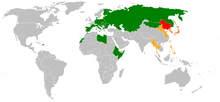
China did not recognize Manchukuo but the two sides established official ties for trade, communications and transportation. In 1933, the League of Nations adopted the Lytton Report, declaring that Manchuria remained rightfully part of China, leading Japan to resign its membership. The Manchukuo case persuaded the United States to articulate the so-called Stimson Doctrine, under which international recognition was withheld from changes in the international system created by force of arms.
In spite of the League of Nations' approach, the new state was diplomatically recognised by El Salvador (3 March 1934) and the Dominican Republic (1934), Italy (29 November 1937), Spain (2 December 1937), Germany (12 May 1938) and Hungary (9 January 1939). The Soviet Union extended de facto recognition on 23 March 1935, but explicitly noted that this did not mean de jure recognition.[23][24]
It is commonly believed that the Holy See established diplomatic relations with Manchukuo in 1934, but the Holy See never did so. This belief is partly due to the erroneous reference in Bernardo Bertolucci's 1987 film The Last Emperor that the Holy See diplomatically recognised Manchukuo. Bishop Auguste Ernest Pierre Gaspais was appointed as "representative ad tempus of the Holy See and of the Catholic missions of Manchukuo to the government of Manchukuo" by the Congregation De Propaganda Fide (a purely religious body responsible for missions) and not by the Secretariat of State responsible for diplomatic relations with states.[25]
After the outbreak of World War II, the state was recognised by Slovakia (1 June 1940), Vichy France (12 July 1940), Romania (1 December 1940), Bulgaria (10 May 1941), Finland (18 July 1941), Denmark (August 1941), Croatia (2 August 1941)—all controlled or influenced by Japan's ally Germany — as well as by China's Wang Jingwei government (30 November 1940), Thailand (5 August 1941) and the Philippines (1943) — all under the control or influence of Japan.
World War II and aftermath
Before World War II, the Japanese colonized Manchukuo and used it as a base from which to invade China. In the summer of 1939 a border dispute between Manchukuo and the Mongolian People's Republic resulted in the Battle of Khalkhin Gol. During this battle, a combined Soviet-Mongolian force defeated the Japanese Kwantung Army (Kantōgun) supported by limited Manchukuoan forces.
On 8 August 1945, the Soviet Union declared war on Japan, in accordance with the agreement at the Yalta Conference, and invaded Manchukuo from outer Manchuria and Outer Mongolia. This was called Manchurian Strategic Offensive Operation. During the Soviet offensive the Army of Manchukuo, on paper a 200,000-man force, performed poorly and whole units surrendered to the Soviets without firing a single shot; there were even cases of armed riots and mutinies against the Japanese forces. Emperor Kangde (known by reign title Xuantong during the Qing Dynasty; his childhood name was Puyi) had hoped to escape to Japan to surrender to the Americans, but the Soviets captured him and eventually extradited him to the communist government in China, where the authorities had him imprisoned as a war criminal along with all other captured Manchukuo officials.
From 1945 to 1948, Manchuria (Inner Manchuria) served as a base area for the People's Liberation Army in the Chinese Civil War against the National Revolutionary Army.[26] The Chinese Communists used Manchuria as a staging ground until the final Nationalist retreat to Taiwan in 1949. Many Manchukuo army and Japanese Kantogun personnel served with the communist troops during the Chinese Civil War against the Nationalist forces. Most of the 1.5 million Japanese who had been left in Manchukuo at the end of World War II were sent back to their homeland in 1946-1948 by U.S. Navy ships in the operation now known as the Japanese repatriation from Huludao.
Politics
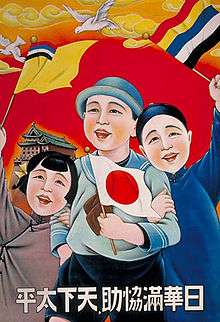
Historians generally consider Manchukuo a puppet state of Imperial Japan[27] because of the Japanese military's strong presence and strict control of the government administration. Chinese historians generally refer to the state as 'Wei Manzhouguo' ('false state of Manchuria'). Some historians see Manchukuo as an effort at building a glorified Japanese state in mainland Asia that deteriorated due to the pressures of war.[28]
The independence of Manchuria was proclaimed on 18 February 1932, and it was renamed Manchukuo. The Japanese military commander appointed Puyi as regent (reign name Datong) for the time being, stating that he would become Emperor of Manchukuo but could not reign using the title of Emperor of the Great Qing Empire as he once held. Manchukuo was proclaimed a monarchy on 1 March 1934, with Puyi assuming the throne under the reign name of Emperor Kang-de. Puyi was assisted in his executive duties by a Privy Council (Chinese: 參議府), and a General Affairs State Council (Chinese: 國務院). This State Council was the center of political power, and consisted of several cabinet ministers, each assisted by a Japanese vice-minister.
The commanding officer of the Kwantung Army in Manchukuo was also the Japanese ambassador to Manchukuo. He functioned in a manner similar to that of a British resident officer in British overseas protectorates, with the power to veto decisions by the emperor. The Kwangtung Army leadership placed Japanese vice ministers in his cabinet, while all Chinese advisors gradually resigned or were dismissed.
The Legislative Council (Chinese: 立法院) was largely a ceremonial body, existing to rubber-stamp decisions issued by the State Council. The only authorized political party was the government-sponsored Concordia Association, although various émigré groups were permitted their own political associations.
When the Japanese surrender was announced on 15 August 1945, Puyi agreed to abdicate.
Head of State
| Emperor of Manchukuo | |
|---|---|
|
Imperial | |
|
Imperial Standard | |
|
Kāngdé | |
| Details | |
| Style | His Imperial Majesty |
| First monarch | Kāngdé |
| Last monarch | Kāngdé |
| Formation | 1 March 1934 |
| Abolition | 15 August 1945 |
| Residence | Imperial Palace |
| Pretender(s) | Jin Yuzhang |
| Personal Names | Period of Reigns | Era names (年號) and their corresponding range of years | ||
|---|---|---|---|---|
| All given names in bold. | ||||
| Aisin-Gioro Puyi 愛新覺羅溥儀 Àixīnjuéluó Pǔyì | 9 March 1932 – 15 August 1945 | Datong (大同 Dàtóng) 1932–1934 Kangde (康德 Kāngdé) 1934–1945 | ||
Prime Minister
| № | Portrait | Name (Birth–Death) |
Term of Office | Party | |
|---|---|---|---|---|---|
| 1 | 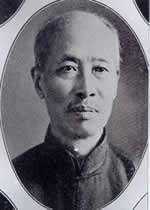 | Zheng Xiaoxu (1860–1938) | 9 March 1932 | 21 May 1935 | Concordia Association |
| 2 | | Zhang Jinghui (1871–1959) | 21 May 1935 | 15 August 1945 | Concordia Association |
Administrative divisions
- See List of administrative divisions of Manchukuo for a complete list of prefecture-level divisions.
During its short-lived existence, Manchukuo was divided into between five (in 1932) and 19 (in 1941) provinces, one special ward of Beiman (Chinese: 北滿特別區) and two Special cities which were Xinjing (Chinese: 新京特別市) and Harbin (Chinese: 哈爾濱特別市). Each province was divided into between four (Xing'an dong) and 24 (Fengtian) prefectures. Beiman lasted less than 3 years (1 July 1933 – 1 January 1936) and Harbin was later incorporated into Binjiang province. Longjiang also existed as a province in the 1932 before being divided into Heihe, Longjiang and Sanjiang in 1934. Andong and Jinzhou provinces separated themselves from Fengtian while Binjiang and Jiandao from Jilin separated themselves in the same year.
Demographics
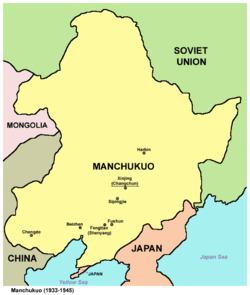
In 1908, the number of residents was 15,834,000, which rose to 30,000,000 in 1931 and 43,000,000 for the Manchukuo state. The population balance remained 123 men to 100 women and the total number in 1941 was 50,000,000. Other statistics indicate that in Manchukuo the population rose by 18,000,000.
In early 1934, the total population of Manchukuo was estimated as 30,880,000, with 6.1 persons the average family, and 122 men for each 100 women. These numbers included 29,510,000 Chinese (96%, which should have included the Manchurian population), 590,760 Japanese (2%), 680,000 Koreans (2%), and 98,431 (<1%) of other nationality: White Russians, Mongols, etc. Around 80% of the population was rural. During the existence of Manchukuo, the ethnic balance did not change significantly, except that Japan increased the Korean population in China. The majority of Han Chinese in Manchukuo believed that Manchuria was rightfully part of China, who both passively and violently resisted Japan's propaganda that Manchukuo was a "multinational state".[29]
From Japanese sources come these numbers: in 1940 the total population in Manchukuo of Lungkiang, Jehol, Kirin, Liaoning (Fengtian) and Xing'an provinces at 43,233,954; or an Interior Ministry figure of 31,008,600. Another figure of the period estimated the total population as 36,933,000 residents.
Around the same time the Soviet Union was advocating the Siberian Jewish Autonomous Oblast across the Manchukuo-Soviet border, some Japanese officials investigated a plan (known as the Fugu Plan) to attract Jewish refugees to Manchukuo as part of their colonisation efforts which was never adopted as official policy.
The Japanese Ueda Kyōsuke labelled all 30 million people in Manchuria as "Manchus", including Han Chinese, despite the fact that most of them were not ethnic Manchu, and the Japanese written "Great Manchukuo" built upon Ueda's argument to claim that all 30 million "Manchus" in Manchukuo had the right to independence to justify splitting Manchukuo from China.[30] In 1942 the Japanese written "Ten Year History of the Construction of Manchukuo" attempted to emphasize the right of ethnic Japanese to the land of Manchukuo while attempting to delegitimize the Manchu's claim to Manchukuo as their native land, noting that most Manchus moved out during the Qing period and only returned later.[31]
Population of main cities
- Niuzhuang (119,000 or 180,871 in 1940)
- Mukden (339,000 or 1,135,801 in 1940)
- Xinjing (126,000 or 544,202 in 1940)
- Harbin (405,000 or 661,948 in 1940)
- Dairen (400,000 or 555,562 in 1939)
- Andong (92,000 or 315,242 in 1940)
- Kirin (119,000 or 173,624 in 1940)
- Tsitsihar (75,000 in 1940)
Japanese population
In 1931–2, there were 100,000 Japanese farmers; other sources mention 590,760 Japanese inhabitants. Other figures for Manchukuo speak of a Japanese population 240,000 strong, later growing to 837,000. In Xinjing, they made up 25% of the population. The Japanese government had official plans projecting the emigration of 5 million Japanese to Manchukuo between 1936 and 1956. Between 1938 and 1942 a batch of young farmers of 200,000 arrived in Manchukuo; joining this group after 1936 were 20,000 complete families. When Japan lost sea and air control of the Yellow Sea, this migration stopped.
When the Red Army invaded Manchukuo, they captured 850,000 Japanese settlers. With the exception of some civil servants and soldiers, these were repatriated to Japan in 1946–7. Many Japanese orphans in China were left behind in the confusion by the Japanese government and were adopted by Chinese families. Many, however, integrated well into Chinese society. In the 1980s Japan began to organise a repatriation programme for them but not all chose to go back to Japan.
The majority of Japanese left behind in China were women, and these Japanese women mostly married Chinese men and became known as "stranded war wives" (zanryu fujin).[32][33] Because they had children fathered by Chinese men, the Japanese women were not allowed to bring their Chinese families back with them to Japan so most of them stayed. Japanese law only allowed children fathered by Japanese fathers to become Japanese citizens.
Economy
Manchukuo experienced rapid economic growth and progress in its social systems. During the 1920s, the Japanese Army under the influence of the Wehrstaat (Defense State) theories popular with the Reichswehr had started to advocate their own version of the Wehrstaat, the totalitarian "national defense state" which would mobilize an entire society for war in peacetime.[34] An additional influence on the Japanese "total war" school who tended to be very anti-capitalist was the First Five Year Plan in the Soviet Union, which provided an example of rapid industrial growth achieved without capitalism.[34] At least part of the reason why the Kwangtung Army seized Manchuria in 1931 was to use it as an laboratory for creating an economic system geared towards the "national defense state"; colonial Manchuria offered up possibilities for the army carrying out drastic economic changes that were not possible in Japan.[34] From the beginning, the Army intended to turn Manchukuo into the industrial heartland of the empire, and starting in 1932, the Army sponsored a policy of forced industrialization that was closely modeled after the Five Year Plan in the Soviet Union.[35] Reflecting their dislike of capitalism, the Zaibatsu were excluded from Manchukuo and all of the heavy industrial factories were built and owned by Army-owned corporations.[35] In 1935, there was a change when the "reform bureaucrat" Nobusuke Kishi was appointed Deputy Minister of Industrial Development.[35] Kishi persuaded the Army to allow the zaibatsu to invest in Manchukuo, arguing that having the state carry out the entire industrialization of Manchukuo was costing too much money.[35] Kishi pioneered an etatist system where bureaucrats such as himself developed economic plans, which the zaibatsu had to then carry out.[35] Kishi succeeded in marshaling private capital in a very strongly state-directed economy to achieve his goal of vastly increased industrial production while at the same time displaying utter indifference to the exploited Chinese workers toiling in Manchukuo's factories; the American historian Mark Driscoll described Kishi's system as a “necropolitical” system where the Chinese workers were literally treated as dehumanized cogs within a vast industrial machine.[36] The system that Kishi pioneered in Manchuria of a state-guided economy where corporations made their investments on government orders later served as the model for Japan's post-1945 development, albeit not with same level of brutal exploitation as in Manchukuo.[36] By the 1930s, Manchukuo's industrial system was among the most advanced making it one of the industrial powerhouses in the region.[37] Manchukuo's steel production exceeded Japan's in the late 1930s. Many Manchurian cities were modernised during Manchukuo era. However, much of the country's economy was often subordinated to Japanese interests and, during the war, raw material flowed into Japan to support the war effort. Traditional lands were taken and redistributed to Japanese farmers with local farmers relocated and forced into collective farming units over smaller areas of land.
See also:
- Central Bank of Manchou
- Manchukuo yuan
- Manshukoku Hikoki Seizo KK
- Manshukoku Koku KK
- Showa Steel Works
- Manchurian Industrial Development Company
- Manchukuo Film Association
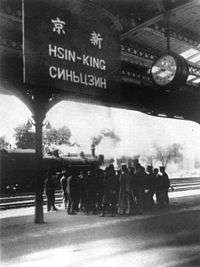
Transport
The Japanese built an efficient and impressive railway system that still functions well today. Known as the South Manchuria Railway Company or Mantetsu, this large corporation came to own large stakes in many industrial projects throughout the region. Mantetsu personnel were active in the pacification of occupied China during World War II.
Military
Manchukuo Imperial Army
The Manchukuo Imperial Army was the armed force of Manchukuo.
- Imperial Manchukuo Police Service
- Hoankyoku (Manchukuo intelligence agency)
Manchukuo Imperial Guards
The Manchukuo Imperial Guards was the elite unit of the Manchukuo armed forces created in 1933. It was charged with the protection of the emperor and senior members of the civil government. Its headquarters was in the capital of Hsinking, near the Imperial Palace in the centre of the city.
Manchukuo Imperial Navy
The Manchukuo Imperial Navy (Manshu Teikoku Kaigun) was the navy of Manchukuo. As Manchukuo was a largely land-locked state, the leadership of the Japanese Kwantung Army regarded the development of a navy to have a very low military priority, although it was politically desirable to create at least a nominal force as a symbol of the legitimacy of the new regime.
Manchukuo Imperial Air Force
The Manchukuo Imperial Air Force (Dai Manshū Teikoku Kūgun) was established in February 1937 with 30 men selected from the Manchukuo Imperial Army who were trained at the Japanese Kwantung Army aircraft arsenal in Harbin. The air force's predecessor was the Manchukuo Air Transport Company (later renamed the Manchukuo National Airways), a paramilitary airline formed in 1931, which undertook transport and reconnaissance missions for the Japanese military.
War crimes in Manchukuo
According to a joint study by historians Zhifen Ju, Mitsuyochi Himeta, Toru Kubo and Mark Peattie, more than 10 million Chinese civilians were mobilized by the Kwangtung Army for slave labor in Manchukuo under the supervision of the Kōa-in.[38]
The Chinese slave laborers often suffered illness due to high-intensity manual labor. Some badly ill workers were directly pushed into mass graves in order to avoid the medical expenditure[39] and the world's most serious mine disaster, at Benxihu Colliery, happened in Manchukuo.
Bacteriological weapons were experimented on humans by the infamous unit 731 located near Harbin in Beinyinhe from 1932 to 1936 and to Pingfan until 1945. Victims, mostly Chinese, Russians and Koreans, were subjected to vivisection, sometimes without anesthesia.
Drug trafficking
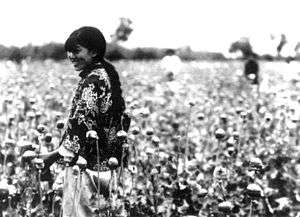
In 2007, an article by Reiji Yoshida in the Japan Times argued that Japanese investments in Manchukuo were partly financed by selling drugs. According to the article, a document found by Yoshida shows that the Kōa-in was directly implicated in providing funds to drug dealers in China for the benefit of the puppet government of Manchukuo, Nanjing and Mongolia.[40] This document corroborates evidence analyzed earlier by the Tokyo tribunal which stated that
Japan's real purpose in engaging in drug traffic was far more sinister than even the debauchery of Chinese people. Japan, having signed and ratified the opium conventions, was bound not to engage in drug traffic, but she found in the alleged but false independence of Manchukuo a convenient opportunity to carry on a worldwide drug traffic and cast the guilt upon that puppet state.... In 1937, it was pointed out in the League of Nations that 90% of all illicit white drugs in the world were of Japanese origin...[41]
Education
Manchukuo developed an efficient public education system. The government established many schools and technical colleges, 12,000 primary schools in Manchukuo, 200 middle schools, 140 normal schools (for preparing teachers), and 50 technical and professional schools. In total the system had 600,000 children and young pupils and 25,000 teachers. Local Chinese children and Japanese children usually attended different schools, and the ones who did attend the same school were segregated by ethnicity, with the Japanese students assigned to better-equipped classes.
Confucius's teachings also played an important role in Manchukuo's public school education. In rural areas, students were trained to practice modern agricultural techniques to improve production. Education focused on practical work training for boys and domestic work for girls, all based on obedience to the "Kingly Way" and stressing loyalty to the Emperor. The regime used numerous festivals, sport events, and ceremonies to foster loyalty of citizens.[42] Eventually, Japanese became the official language in addition to the Chinese taught in Manchukuo schools.
Culture
Film
The Photographic Division, part of the public relations section of the South Manchurian Railway was created in 1928 to produce short documentary films about Manchuria to Japanese audiences. In 1937, the Manchukuo Film Association was established by the government and the South Manchurian Railway in a studio in Jilin province. It was founded by Masahiko Amakasu, who also helped the career of Yoshiko Otaka, also known as Ri Koran. He also tried to ensure that Manchukuo would have its own industry and would be catering mainly to Manchurian audiences. The films for the most part usually promote pro-Manchukuo and pro-Japanese views. After World War II, the archives and the equipment of the association were used by the Changchun Film Studio of the People's Republic of China.
Dress
The Changshan and the Qipao, both derived from traditional Manchu dress, were considered national dresses in Manchukuo.
In a meeting with the Concordia Association, the organizers devised what was termed Concordia Costume, or the kyowafuku, in 1936. Even Japanese like Masahiko Amakasu and Kanji Ishiwara adopted it. It was gray and a civilianized version of Imperial Japanese Army uniform. It was similar to the National Clothes (kokumin-fuku) worn by Japanese civilians in World War II as well as the Zhongshan suit. A pin of either a Manchukuo flag or a five-pointed, five colored star with the Manchukuo national colors were worn on the collars.[43] Court dress resembled those of Meiji-era Japan at that time.
Sport
The Manchukuo National Physical Education Association was established in 1932 to promote sport.
Manchukuo also had a national football team, and football was considered the country's de facto national sport; the Football Association of Manchukuo was formed around it.[44]
Manchukuo hosted and participated in baseball matches with Japanese teams. Some of the games of the Intercity Baseball Tournament were held in the country, and played with local teams.
Manchukuo was to compete in the 1932 Summer Olympic Games, but one of the athletes who intended to represent Manchukuo, Liu Changchun, refused to join the team and instead joined as the first Chinese representative in the Olympics. There were attempts by Japanese authorities to let Manchukuo join the 1936 games, but the Olympic Committee persisted in the policy of not allowing an unrecognized state to join the Olympics. Manchukuo had a chance to participate in the planned 1940 Tokyo Olympics, but the onset of World War II prevented the games from taking place.
National symbols
Aside from the national flag, the orchid, reportedly Puyi's favorite flower, became the royal flower of the country, similar to the chrysanthemum in Japan.[45] The sorghum flower also became a national flower by decree in April 1933.[46] "Five Races Under One Union (Manchukuo)" was used as a national motto.
Stamps and postal history
Manchukuo issued postage stamps from 28 July 1932 until its dissolution following the final defeat of the Japanese Empire in August 1945. The last issue of Manchukuo was on 2 May 1945.
In popular culture
In Masaki Kobayashi's The Human Condition (1959), Kaji, the main protagonist, is a labor supervisor assigned to a workforce consisting of Chinese prisoners in a large mining operation in Japanese-colonized Manchuria.
Bernardo Bertolucci's 1987 film The Last Emperor presented a portrait of Manchukuo through the memories of Emperor Puyi, during his days as a political prisoner in the People's Republic of China.
Haruki Murakami's 1995 novel The Wind-Up Bird Chronicle deals greatly with Manchukuo through the character of Lieutenant Mamiya. Mamiya recalls, in person and in correspondence, his time as an officer in the Kwantung Army in Manchukuo. While the period covered in these recollections extends over many years, the focus is on the final year of the war and the Soviet invasion of Manchuria. Also, in his 2011 magical realist novel 1Q84, Murakami references the Manchukuo puppet state, Manchuria and the Trans-Siberian Railway in various character backstories.
The 2008 South Korean western The Good, the Bad, the Weird is set in the desert wilderness of 1930s Manchuria.
See also
Part of a series on the |
|---|
| History of Manchuria |
|
Medieval period |
- Battle of Khalkhin Gol
- Battle of Lake Khasan
- Collaborationist Chinese Army
- Evacuation of Manchukuo
- Fengtian Clique
- History of the Republic of China
- Japanization
- Kuomintang
- List of East Asian leaders in the Japanese sphere of influence (1931–1945)
- Manchukuo Temporary Government
- Marco Polo Bridge Incident
- Mengkukuo
- Mukden Incident
- Nomonhan
- Northeast Anti-Japanese United Army
- Soviet invasion of Manchuria
- Unit 731
Notes
- ↑ Although the territories came under the jurisdiction of the Nationalist government before the Chinese Civil War came to its conclusion in 1949, the brief Soviet occupation helped transform the region into a power base for the Chinese Communist troops led by Mao Zedong where the People's Liberation Army could resupply itself with Japanese equipment and gain strategic advantage against the Nationalist government headed by Chiang Kai-shek.
References
Citations
- ↑ Mitani, Hiromi (1996). "A study of Manchukuo's language policy : the representation of nation and national language in the new school system". Essays and studies. 46 (2).
- ↑ Encyclopædia Britannica article on Manchukuo
- ↑ C. Peter Chen. "Manchurian Strategic Offensive Operation | World War II Database". World War II Database. Retrieved 2015-09-10.
- ↑ Wjat 'Manju' Was in the Beginning and When it Grew into a Place-name Pozzi 2006, p. 159.
- ↑ Wjen did 'Manju' Become a Place-name? Pozzi 2006, p. 167.
- ↑ Elliot 2000, p. 626.
- ↑ Elliot 2000, p. 628.
- ↑ ed. Wolff & Steinberg 2007, p. 514.
- ↑ ed. Edgington 2003, p. 114.
- ↑ McCormack 1977, p. 4.
- ↑ Pʻan 1938, p. 8.
- ↑ Smith 2012, p. 219.
- ↑ Tamanoi 2000, p. 249.
- ↑ China and the ManchusGiles 1912, p. 8.
- ↑ Garcia 2012, p. 15.
- ↑ Hauer 2007, p. 117.
- ↑ Dvořák 1895, p. 80.
- ↑ Wu 1995, p. 102.
- ↑ Zhao 2006, pp. 4, 7, 8, 9, 10, 12, 13, 14.
- ↑ Clausen 1995, p. 7.
- ↑ Reginald Fleming Johnston, p. 438.
- ↑ Between World Wars
- ↑ Nish, Ian Hill (2002), Japanese foreign policy in the interwar period, Westport, CT: Praeger, p. 95, ISBN 0-275-94791-2
- ↑ Turns, David. "Stimson Doctrine of Non-Recognition: Its Historical Genesis and Influence on Contemporary International Law, The." Chinese J. Int'l L. 2 (2003): 123.
- ↑ Valente, Gianni. "Vatican-Manchukuo, mea culpas are not necessary". 30giorni. Archived from the original on 25 February 2013. Retrieved February 25, 2013.
- ↑ Borisov, O. (1977). The Soviet Union and the Manchurian Revolutionary Base (1945-1949). Moscow, Progress Publishers.
- ↑ Columbia Encyclopedia article on Manchukuo
- ↑ Doak, Kevin Michael (2004), "Review: Sovereignty and Authenticity: Manchukuo and the East Asian Modern by Prasenjit Duara", The Journal of Japanese Studies, 30 (2): 502–507, ISSN 0095-6848, JSTOR 25064511
- ↑ Westad, Odd Arne (2012). Restless Empire: China and the World Since 1750. Basic Bokos. p. 252.
- ↑ Tamanoi 2000, p. 253.
- ↑ Tamanoi 2000, p. 255.
- ↑ Left Behind: Japan's Wartime Defeat and the Stranded Women of Manchukuo
- ↑ Mackerras 2003, p. 59.
- 1 2 3 Maiolo, Joseph Cry Havoc How the Arms Race Drove the World to War, 1931-1941, New York: Basic Books, 2010 pages 28-29
- 1 2 3 4 5 Maiolo, Joseph Cry Havoc How the Arms Race Drove the World to War, 1931-1941, New York: Basic Books, 2010 page 30
- 1 2 "The Unquiet Past Seven decades on from the defeat of Japan, memories of war still divide East Asia". The Economist. 12 August 2015. Retrieved 2015-09-09.
- ↑ Prasenjit Duara. "The New Imperialism and the Post-Colonial Developmental State: Manchukuo in comparative perspective". Retrieved 25 July 2010.
- ↑ Ju, Zhifen (2002), Japan's atrocities of conscripting and abusing north China draftees after the outbreak of the Pacific war
- ↑ Municipal Government Information Office (2005), Repatriation of one million Japanese via Huludao, Beijing: China Intercontinental Press, p. 25, ISBN 7-5085-0735-5
- ↑ Japan profited as opium dealer wartime China
- ↑ Chapter 5: HyperWar: International Military Tribunal for the Far East
- ↑ Japan Focus.
- ↑ Brandt, Kim. Kingdom of Beauty: Mingei and the Politics of Folk Art in Imperial Japan. Durham and London: Duke UP, 2007.
- ↑ "満州国の国技は"蹴球"-読売新聞記事より : 蹴球本日誌". fukuju3.cocolog-nifty.com. 2010-10-01. Retrieved 2015-09-10.
- ↑ "国立公文書館 アジア歴史資料センター". jacar.go.jp. Retrieved 2015-09-10.
- ↑ 千田萬三『満洲事典』満鉄社員会、1939年(昭和14年)
Works cited
- Clausen, Søren (1995). The Making of a Chinese City: History and Historiography in Harbin. Contributor: Stig Thøgersen (illustrated ed.). M.E. Sharpe. ISBN 1563244764. Retrieved 10 March 2014.
- Dvořák, Rudolf (1895). Chinas religionen ... Volume 12; Volume 15 of Darstellungen aus dem Gebiete der nichtchristlichen Religionsgeschichte (illustrated ed.). Aschendorff (Druck und Verlag der Aschendorffschen Buchhandlung). ISBN 0199792054. Retrieved 10 March 2014.
- Elliott, Mark C. (Aug 2000). "The Limits of Tartary: Manchuria in Imperial and National Geographies". The Journal of Asian Studies. Association for Asian Studies. 59 (No. 3): 603–646. doi:10.2307/2658945. JSTOR 2658945. Archived from the original
|archive-url=requires|url=(help) on 2012-08-17. - Garcia, Chad D. (2012). Horsemen from the Edge of Empire: The Rise of the Jurchen Coalition (PDF) (A dissertation submitted in partial fulfillment of the requirements for the degree of Doctor of Philosophy). University of Washington. pp. 1–315. Retrieved 6 September 2014.
- Giles, Herbert A. (1912). China and the Manchus. (Cambridge : at the University Press) (New York : G. P. Putnam's Sons). Retrieved 31 January 2014.
- Hauer, Erich (2007). Corff, Oliver, ed. Handwörterbuch der Mandschusprache. Volume 12; Volume 15 of Darstellungen aus dem Gebiete der nichtchristlichen Religionsgeschichte (illustrated ed.). Otto Harrassowitz Verlag. ISBN 3447055286. Retrieved 10 March 2014.
- McCormack, Gavan (1977). Chang Tso-lin in Northeast China, 1911-1928: China, Japan, and the Manchurian Idea (illustrated ed.). Stanford University Press. ISBN 0804709459. Retrieved 10 March 2014.
- Pʻan, Chao-ying (1938). American Diplomacy Concerning Manchuria. The Catholic University of America. Retrieved 10 March 2014.
- Pozzi, Alessandra; Janhunen, Juha Antero; Weiers, Michael, eds. (2006). Tumen Jalafun Jecen Aku: Manchu Studies in Honour of Giovanni Stary. Volume 20 of Tunguso Sibirica. Contributor: Giovanni Stary. Otto Harrassowitz Verlag. ISBN 344705378X. Retrieved 1 April 2013.
- Sewell, Bill (2003). Edgington, David W., ed. Japan at the Millennium: Joining Past and Future (illustrated ed.). UBC Press. ISBN 0774808993. Retrieved 10 March 2014.
- Smith, Norman (2012). Intoxicating Manchuria: Alcohol, Opium, and Culture in China's Northeast. Contemporary Chinese Studies Series (illustrated ed.). UBC Press. ISBN 077482431X. Retrieved 10 March 2014.
- Tamanoi, Mariko Asano (May 2000). "Knowledge, Power, and Racial Classification: The "Japanese" in "Manchuria"". The Journal of Asian Studies. Association for Asian Studies. 59 (No. 2): 248–276. doi:10.2307/2658656. JSTOR 2658656.
- Wolff, David; Steinberg, John W., eds. (2007). The Russo-Japanese War in Global Perspective: World War Zero, Volume 2. Volume 2 of The Russo-Japanese War in Global Perspective (illustrated ed.). BRILL. ISBN 9004154167. Retrieved 1 April 2013.
- Wu, Shuhui (1995). Die Eroberung von Qinghai unter Berücksichtigung von Tibet und Khams 1717 - 1727: anhand der Throneingaben des Grossfeldherrn Nian Gengyao. Volume 2 of Tunguso Sibirica (reprint ed.). Otto Harrassowitz Verlag. ISBN 3447037563. Retrieved 10 March 2014.
- Zhao, Gang (January 2006). "Reinventing China Imperial Qing Ideology and the Rise of Modern Chinese National Identity in the Early Twentieth Century" (PDF). 32 (Number 1). Sage Publications. doi:10.1177/0097700405282349. JSTOR 20062627. Archived from the original on 25 March 2014.
Other sources
- KISHI Toshihiko, MATSUSHIGE Mitsuhiro and MATSUMURA Fuminori eds, 20 Seiki Manshu Rekishi Jiten [Encyclopedia of 20th Century Manchuria History], Tokyo: Yoshikawa Kobunkan, 2012, ISBN 978-4642014694
- Toshihiko Kishi. "Manchuria's Visual Media Empire (Manshukoku no Visual Media): Posters, Pictorial Post Cards, Postal Stamps", Tokyo: Yoshikawa Kobunkan, 10 June 2010. ISBN 978-4-642-08036-1
- Reginald Fleming Johnston. "Twilight in the Forbidden City". Soul Care Publishing, 18 March 2008. ISBN 978-0-9680459-5-4.
Further reading
- Clauss, Errol MacGregor. "The Roosevelt Administration and Manchukuo, 1933-1941," Historian (1970), 32#4 pp 595–611.
- Duara, Prasenjit. Sovereignty and Authenticity: Manchukuo and the East Asian Modern (2004)
- DuBois, Thomas David, "Inauthentic Sovereignty: Law and Legal Institutions in Manchukuo," Journal of Asian Studies 3 (2010), pp. 1–22.
- Power, Brian. Puppet Emperor: The Life of Pu Yi, Last Emperor of China (1988), 240pp
- Yamamuro, Shin'ichi. Manchuria under Japanese Dominion (U. of Pennsylvania Press, 2006); 335 pages; translation of highly influential Japanese study; excerpt and text search
- review in The Journal of Japanese Studies 34.1 (2007) 109-114 online
- Young, Louise. Japan's Total Empire: Manchuria and the Culture of Wartime Imperialism (1999) 500pp; excerpt and text search; Google books
- Mitter, Rana. The Manchurian Myth: Nationalism, Resistance, and Collaboration in Modern China (2000) 295pp.
External links
| Wikimedia Commons has media related to Manchukuo. |
- Manchukuo Propaganda Posters & Bills
- Manchukuo Imperial Army
- Manchu Money Museum
- Education in Mongolia and Manchukuo
- Manchukuo Flags
- "On Macro-economic Statistics for Manchukuo" by Yuzo Yamamoto
- "Toshiro Matsumoto s research over Manchukuo"
- "Vaticano-Manchukuo no sirve de mea culpa" by Gianni Valente
- "Manchukuo National Anthem"
- JAPAN-MANCHOUKUO PROTOCOL
- "References over Manchukuo"
- Zionism and the Japanese East Asia Co-Prosperity Sphere
- Japanese references to Mantetsu Railway Company
- Mukden Incident photos
Coordinates: 43°53′N 125°19′E / 43.883°N 125.317°E




